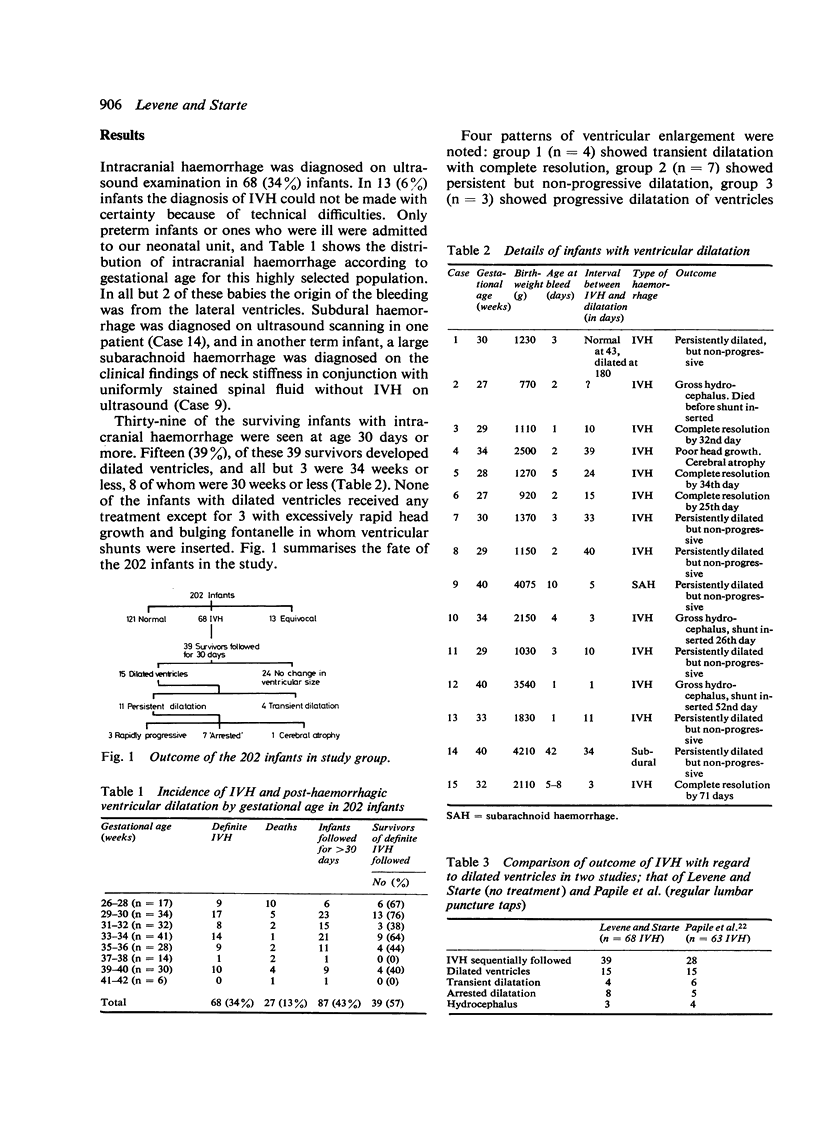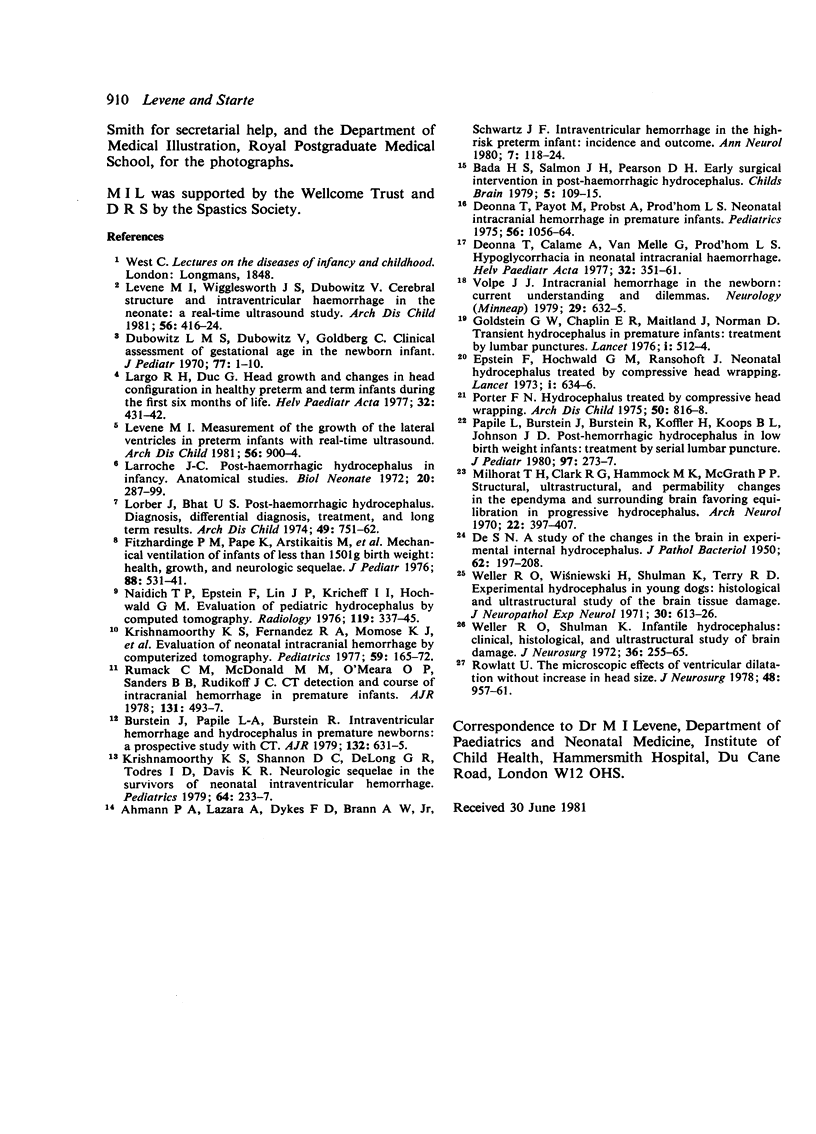Abstract
Two hundred and two consecutive admissions to a regional neonatal unit were scanned by real-time ultrasound. Sixty-eight (34%) infants had intracranial haemorrhage, 39 (57%) of whom were scanned repeatedly until they were at least 30 days old. Fifteen infants showed some degree of ventricular dilatation. Four had transient dilatation with complete recovery without any form of treatment (group 1), 7 showed persistent but non-progressive dilatation with no treatment (group 2), 3 had rapidly progressive hydrocephalus (group 3), and 1 had cerebral atrophy (group 4). Occipitofrontal head circumference was also followed sequentially from birth and was not abnormal in groups 1 and 2, but abnormal rates of head growth were seen in groups 3 and 4. It is concluded that after intracranial haemorrhage only a small proportion of infants develop frank hydrocephalus, but ventricular dilatation of some degree is common and may require no treatment.
Full text
PDF





Images in this article
Selected References
These references are in PubMed. This may not be the complete list of references from this article.
- Ahmann P. A., Lazzara A., Dykes F. D., Brann A. W., Jr, Schwartz J. F. Intraventricular hemorrhage in the high-risk preterm infant: incidence and outcome. Ann Neurol. 1980 Feb;7(2):118–124. doi: 10.1002/ana.410070205. [DOI] [PubMed] [Google Scholar]
- Bada H. S., Salmon J. H., Pearson D. H. Early surgical intervention in posthemorrhagic hydrocephalus. Childs Brain. 1979;5(2):109–115. doi: 10.1159/000119809. [DOI] [PubMed] [Google Scholar]
- Burstein J., Papile L. A., Burstein R. Intraventricular hemorrhage and hydrocephalus in premature newborns: a prospective study with CT. AJR Am J Roentgenol. 1979 Apr;132(4):631–635. doi: 10.2214/ajr.132.4.631. [DOI] [PubMed] [Google Scholar]
- DE S. N. A study of the changes in the brain in experimental internal hydrocephalus. J Pathol Bacteriol. 1950 Apr;62(2):197–208. doi: 10.1002/path.1700620207. [DOI] [PubMed] [Google Scholar]
- Deonna T., Calame A., van Melle G., Prod'hom L. S. Hypoglycorrhachia in neonatal intracranial hemorrhage. Relationship to posthemorrhagic hydrocephalus. Helv Paediatr Acta. 1977 Nov;32(4-5):351–361. [PubMed] [Google Scholar]
- Deonna T., Payot M., Probst A., Prod'hom L. S. Neonatal intracranial hemorrhage in premature infants. Pediatrics. 1975 Dec;56(6):1056–1064. [PubMed] [Google Scholar]
- Dubowitz L. M., Dubowitz V., Goldberg C. Clinical assessment of gestational age in the newborn infant. J Pediatr. 1970 Jul;77(1):1–10. doi: 10.1016/s0022-3476(70)80038-5. [DOI] [PubMed] [Google Scholar]
- Epstein F., Hochwald G. M., Ransohoff J. Neonatal hydrocephalus treated by compressive head wrapping. Lancet. 1973 Mar 24;1(7804):634–636. doi: 10.1016/s0140-6736(73)92200-9. [DOI] [PubMed] [Google Scholar]
- Fitzhardinge P. M., Pape P., Arstikaitis M., Boyle M., Ashby S., Rowley A., Netley C., Swyer P. R. Mechanical ventilation of infants of less than 1,501 gm birth weight: Health, growth, and neurologic sequelae. J Pediatr. 1976 Apr;88(4 Pt 1):531–541. doi: 10.1016/s0022-3476(76)80001-7. [DOI] [PubMed] [Google Scholar]
- Goldstein G. W., Chaplin E. R., Maitland J., Norman D. Transient hydrocephalus in premature infants: Treatment by lumbar punctures. Lancet. 1976 Mar 6;1(7958):512–514. doi: 10.1016/s0140-6736(76)90297-x. [DOI] [PubMed] [Google Scholar]
- Krishnamoorthy K. S., Fernandez R. A., Momose K. J., DeLong G. R., Moylan F. M., Todres I. D., Shannon D. C. Evaluation of neonatal intracranial hemorrhage by computerized tomography. Pediatrics. 1977 Feb;59(2):165–172. [PubMed] [Google Scholar]
- Krishnamoorthy K. S., Shannon D. C., DeLong G. R., Todres I. D., Davis K. R. Neurologic sequelae in the survivors of neonatal intraventricular hemorrhage. Pediatrics. 1979 Aug;64(2):233–237. [PubMed] [Google Scholar]
- Largo R. H., Duc G. Head growth and changes in head configuration in healthy preterm and term infants during the first sex months of life. Helv Paediatr Acta. 1978 Feb;32(6):431–442. [PubMed] [Google Scholar]
- Larroche J. C. Post-haemorrhagic hydrocephalus in infancy. Anatomical study. Biol Neonate. 1972;20(3):287–299. doi: 10.1159/000240472. [DOI] [PubMed] [Google Scholar]
- Levene M. I. Measurement of the growth of the lateral ventricles in preterm infants with real-time ultrasound. Arch Dis Child. 1981 Dec;56(12):900–904. doi: 10.1136/adc.56.12.900. [DOI] [PMC free article] [PubMed] [Google Scholar]
- Levene M. I., Wigglesworth J. S., Dubowitz V. Cerebral structure and intraventricular haemorrhage in the neonate: a real-time ultrasound study. Arch Dis Child. 1981 Jun;56(6):416–424. doi: 10.1136/adc.56.6.416. [DOI] [PMC free article] [PubMed] [Google Scholar]
- Lorber J., Bhat U. S. Posthaemorrhagic hydrocephalus. Diagnosis, differential diagnosis, treatment, and long-term results. Arch Dis Child. 1974 Oct;49(10):751–762. doi: 10.1136/adc.49.10.751. [DOI] [PMC free article] [PubMed] [Google Scholar]
- Milhorat T. H., Clark R. G., Hammock M. K., McGrath P. P. Structural, ultrastructural, and permeability changes in the ependyma and surrounding brain favoring equilibration in progressive hydrocephalus. Arch Neurol. 1970 May;22(5):397–407. doi: 10.1001/archneur.1970.00480230015002. [DOI] [PubMed] [Google Scholar]
- Naidich T. P., Epstein F., Lin J. P., Kricheff I. I., Hochwald G. M. Evaluation of pediatric hydrocephalus by computed tomography. Radiology. 1976 May;119(2):337–345. doi: 10.1148/119.2.337. [DOI] [PubMed] [Google Scholar]
- Papile L. A., Burstein J., Burstein R., Koffler H., Koops B. L., Johnson J. D. Posthemorrhagic hydrocephalus in low-birth-weight infants: treatment by serial lumbar punctures. J Pediatr. 1980 Aug;97(2):273–277. doi: 10.1016/s0022-3476(80)80494-x. [DOI] [PubMed] [Google Scholar]
- Porter F. N. Hydrocephalus treated by compressive head wrapping. Arch Dis Child. 1975 Oct;50(10):816–818. doi: 10.1136/adc.50.10.816. [DOI] [PMC free article] [PubMed] [Google Scholar]
- Rowlatt U. The microscopic effects of ventricular dilatation without increase in head size. J Neurosurg. 1978 Jun;48(6):957–961. doi: 10.3171/jns.1978.48.6.0957. [DOI] [PubMed] [Google Scholar]
- Rumack C. M., McDonald M. M., O'Meara O. P., Sanders B. B., Rudikoff J. C. CT detection and course of intracranial hemorrhage in premature infants. AJR Am J Roentgenol. 1978 Sep;131(3):493–497. doi: 10.2214/ajr.131.3.493. [DOI] [PubMed] [Google Scholar]
- Volpe J. J. Intracranial hemorrhage in the newborn: current understanding and dilemmas. Neurology. 1979 May;29(5):632–635. doi: 10.1212/wnl.29.5.632. [DOI] [PubMed] [Google Scholar]
- Weller R. O., Shulman K. Infantile hydrocephalus: clinical, histological, and ultrastructural study of brain damage. J Neurosurg. 1972 Mar;36(3):255–265. doi: 10.3171/jns.1972.36.3.0255. [DOI] [PubMed] [Google Scholar]
- Weller R. O., Wiśniewski H., Shulman K., Terry R. D. Experimental hydrocephalus in young dogs: histological and ultrastructural study of the brain tissue damage. J Neuropathol Exp Neurol. 1971 Oct;30(4):613–626. [PubMed] [Google Scholar]




